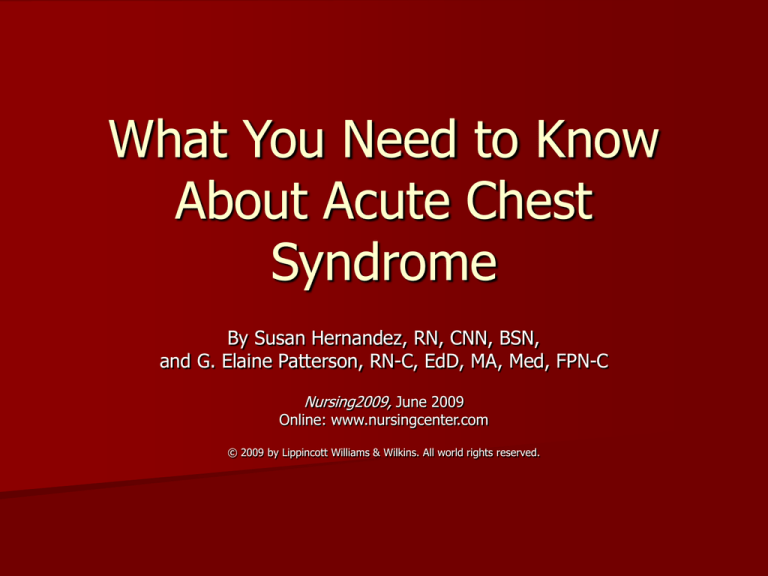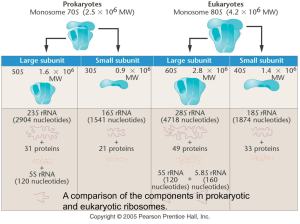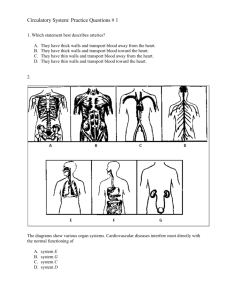
What You Need to Know
About Acute Chest
Syndrome
By Susan Hernandez, RN, CNN, BSN,
and G. Elaine Patterson, RN-C, EdD, MA, Med, FPN-C
Nursing2009, June 2009
Online: www.nursingcenter.com
© 2009 by Lippincott Williams & Wilkins. All world rights reserved.
Acute chest syndrome (ACS)
Potentially life-threatening complication of
sickle-cell disease
Can lead to respiratory failure
ACS is the leading cause of death among
patients with sickle-cell disease
Acute chest syndrome (ACS)
Sickle-cell disease affects 80,000
Americans
Inherited disorder
Seen in equatorial African descent,
Mediterranean, East Indian, Middle
Eastern lineage
Background of sickle-cell disease
Hemoglobin is oxygen-carrying protein in
RBCs
Normal adult hemoglobin is designated
hemoglobin A. A patient with sickle-cell
disease has abnormal hemoglobin
(designated hemoglobin S), alone or in
combination with other abnormal
hemoglobin (typically hemoglobin C)
Background of sickle-cell disease
Homozygous form of sickle-cell disease
(hemoglobin SS, or sickle-cell anemia) is
most severe, accounts for about 65% of
cases
Other types are sickle-cell thalassemia and
sickle-cell disease with hemoglobin SC
Background of sickle-cell disease
Signs and symptoms of sickle-cell disease
are caused by elongated and rigid
hemoglobin S
Abnormal RBCs cause vascular occlusions,
creating a cycle of more deoxygenation,
sickling, and sluggish blood flow. This
ultimately leads to ischemia and infarction
in distal organs
Background of sickle-cell disease
Abnormal hemoglobin also means RBC has
shorter life (16 days vs. 120 for normal);
leads to chronic intravascular and
extravascular hemolysis
30 years ago, life expectancy was 14
years; now patients are living into 40s and
50s. Acute complications experienced by
adult patients include vaso-occlusive crisis,
ACS, renal failure
Vaso-occlusive crisis
Low oxygen tension causes red blood cells
(RBCs) to lose their round shape
RBCs adhere to each other and the
endothelium
Causes pain, edema, fever, tissue ischemia
Vaso-occlusive crisis
Can be triggered by cold, excessive
physical exertion, late pregnancy,
infection, dehydration, emotional or
mental stress
Many patients hospitalized with vasoocclusive crisis develop ACS
ACS defined
Acute complication
New pulmonary infiltrate on chest X-ray
Accompanied by at least one other new
sign or symptom: fever, chest pain,
coughing, wheezing, tachypnea
Possible causes of ACS
Fat embolism - more common in adults,
diagnosis confirmed with bronchoscopy,
can progress to ARDS
Infection - Chlamydia pneumoniae,
Atelectasis - secondary to hypoventilation
and poor respiratory effort with opioid use
Mycoplasma pneumoniae
Diagnostics
Chest X-ray is cornerstone of diagnosis
Hemoglobin levels
White blood cell count
SpO2
Caring for patients with ACS
Improving oxygenation is first priority;
supplemental oxygen may be given
(incentive spirometry, nebulizer treatments)
Administer opioids as ordered for pain; be
careful of hindering respiratory effort
Continue to assess respiratory, neurologic,
and oversedation status
Caring for patients with ACS
Administer antibiotics as ordered
Administer I.V. fluids to reverse
dehydration and decrease blood viscosity
Monitor intake and output to prevent fluid
overload, which can worsen pulmonary
status
Treatment with hydroxyurea
In patients with three or more episodes of
ACS or acute painful sickle cell crisis in the
previous year
Used long-term to treat adults with
moderate to severe sickle cell disease
Has cytotoxic effects on RBCs
Treatment with hydroxyurea
Reduces WBCs and platelets, which
reduces vascular injury, incidence of ACS
Blood counts monitored every 2 weeks to
establish optimal dose; decreases pain,
increases hemoglobin, provides patient
well-being
Monitor for bone marrow suppression
Treatment with hydroxyurea
All patients should be on reliable
contraception during therapy
If patient’s condition continues to
deteriorate, may need mechanical
ventilation and RBC exchange therapy;
done in ICU






